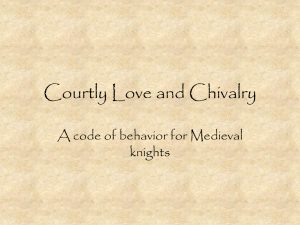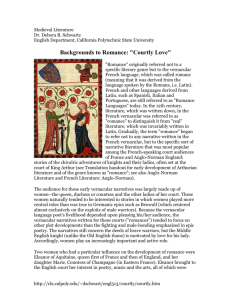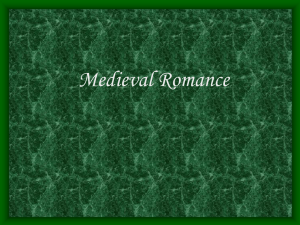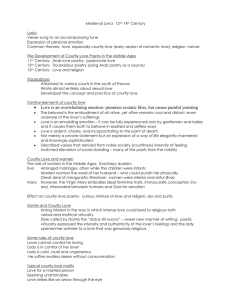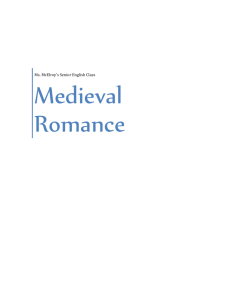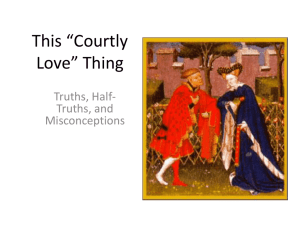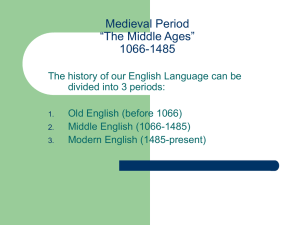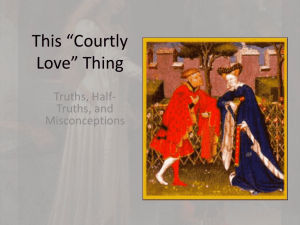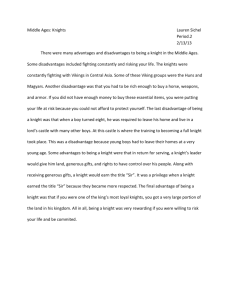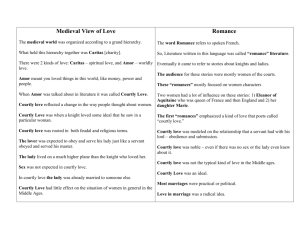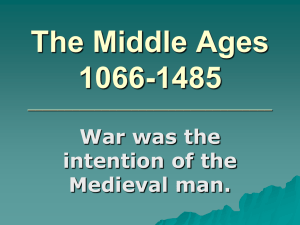Courtly Love
advertisement
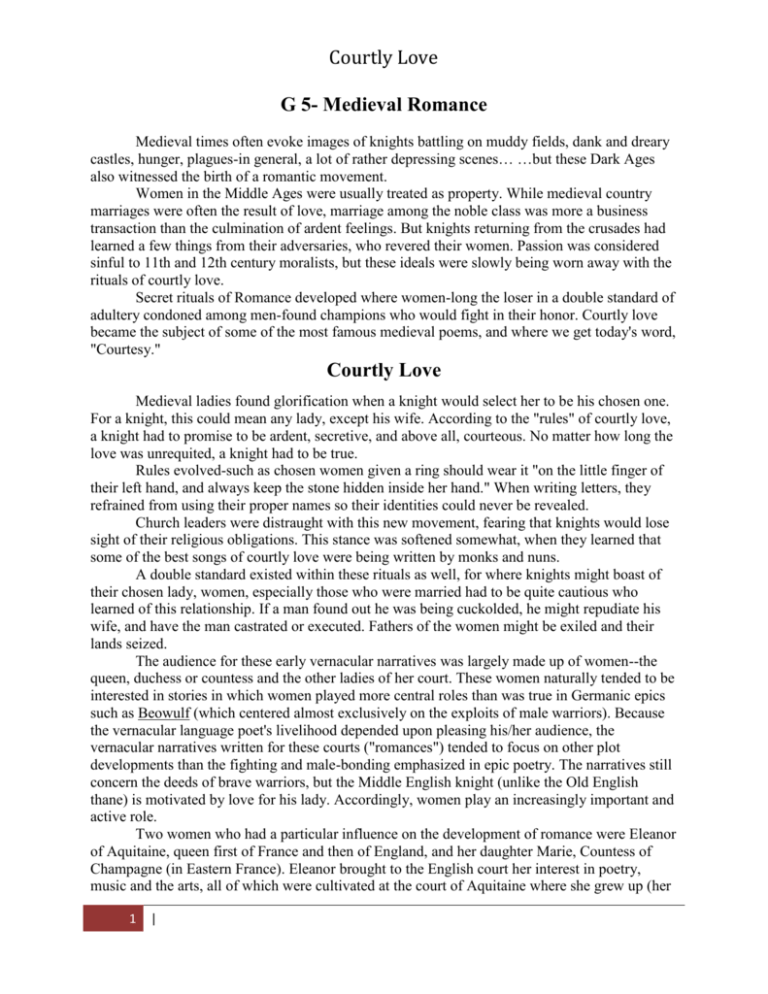
Courtly Love G 5- Medieval Romance Medieval times often evoke images of knights battling on muddy fields, dank and dreary castles, hunger, plagues-in general, a lot of rather depressing scenes… …but these Dark Ages also witnessed the birth of a romantic movement. Women in the Middle Ages were usually treated as property. While medieval country marriages were often the result of love, marriage among the noble class was more a business transaction than the culmination of ardent feelings. But knights returning from the crusades had learned a few things from their adversaries, who revered their women. Passion was considered sinful to 11th and 12th century moralists, but these ideals were slowly being worn away with the rituals of courtly love. Secret rituals of Romance developed where women-long the loser in a double standard of adultery condoned among men-found champions who would fight in their honor. Courtly love became the subject of some of the most famous medieval poems, and where we get today's word, "Courtesy." Courtly Love Medieval ladies found glorification when a knight would select her to be his chosen one. For a knight, this could mean any lady, except his wife. According to the "rules" of courtly love, a knight had to promise to be ardent, secretive, and above all, courteous. No matter how long the love was unrequited, a knight had to be true. Rules evolved-such as chosen women given a ring should wear it "on the little finger of their left hand, and always keep the stone hidden inside her hand." When writing letters, they refrained from using their proper names so their identities could never be revealed. Church leaders were distraught with this new movement, fearing that knights would lose sight of their religious obligations. This stance was softened somewhat, when they learned that some of the best songs of courtly love were being written by monks and nuns. A double standard existed within these rituals as well, for where knights might boast of their chosen lady, women, especially those who were married had to be quite cautious who learned of this relationship. If a man found out he was being cuckolded, he might repudiate his wife, and have the man castrated or executed. Fathers of the women might be exiled and their lands seized. The audience for these early vernacular narratives was largely made up of women--the queen, duchess or countess and the other ladies of her court. These women naturally tended to be interested in stories in which women played more central roles than was true in Germanic epics such as Beowulf (which centered almost exclusively on the exploits of male warriors). Because the vernacular language poet's livelihood depended upon pleasing his/her audience, the vernacular narratives written for these courts ("romances") tended to focus on other plot developments than the fighting and male-bonding emphasized in epic poetry. The narratives still concern the deeds of brave warriors, but the Middle English knight (unlike the Old English thane) is motivated by love for his lady. Accordingly, women play an increasingly important and active role. Two women who had a particular influence on the development of romance were Eleanor of Aquitaine, queen first of France and then of England, and her daughter Marie, Countess of Champagne (in Eastern France). Eleanor brought to the English court her interest in poetry, music and the arts, all of which were cultivated at the court of Aquitaine where she grew up (her 1 | Courtly Love grandfather William was the first known troubadour poet). In the vernacular narratives that were written for and/or dedicated to Eleanor--early "romances"--we find an emphasis on the sort of love relationship that is depicted in troubadour poetry, commonly known as "courtly love" (fin'amors in Provençal, the language of troubadour poetry). The "courtly love" relationship is modeled on the feudal relationship between a knight and his liege lord. The knight serves his courtly lady (love service) with the same obedience and loyalty which he owes to his liege lord. She is in complete control of the love relationship, while he owes her obedience and submission (a literary convention that did not correspond to actual practice!) The knight's love for the lady inspires him to do great deeds, in order to be worthy of her love or to win her favor. Thus "courtly love" was originally construed as an ennobling force whether or not it was consummated, and even whether or not the lady knew about the knight's love or loved him in return. The "courtly love" relationship typically was not between husband and wife, not because the poets and the audience were inherently immoral, but because it was an idealized sort of relationship that could not exist within the context of "real life" medieval marriages. In the middle ages, marriages amongst the nobility were typically based on practical and dynastic concerns rather than on love. The idea that a marriage could be based on love (as in the "Franklin's Tale") was a radical notion. But the audience for romance was perfectly aware that these romances were fictions, not models for actual behavior. The adulterous aspect that bothers many 20th-century readers was somewhat beside the point, which was to explore the potential influence of love on human behavior. Social historians such as Eric Köhler and Georges Duby have hypothesized that "courtly love" may have served a useful social purpose: providing a model of behavior for a class of unmarried young men that might otherwise have threatened social stability. Knights were typically younger brothers without land of their own (hence unable to support a wife) who became members of the household of the feudal lords whom they served. One reason why the lady in the courtly love relationship is typically older, married and of higher social status than the knight may be because she was modeled on the wife of the feudal lord, who might naturally become the focus of the young, unmarried knights' desire. Köhler and Duby posit that the literary model of the courtly love relationship may have been invented in part to provide these young men with a model for appropriate behavior, teaching them to sublimate their desires and to channel their energy into socially useful behavior (love service rather than wandering around the countryside, stealing or raping women like the knight in the "Wife of Bath's" tale). The behavior of the knight and lady in love was drawn partly from troubadour poetry and partly from a set of literary conventions derived from the Latin poet Ovid, who described the "symptoms" of love as if it were a sickness. The "lovesick" knight became a conventional figure in medieval romance. Typical symptoms: sighing, turning pale, turning red, fever, inability to sleep, eat or drink. Romances often contained long interior monologues in which the lovers describe their feelings 2 |
